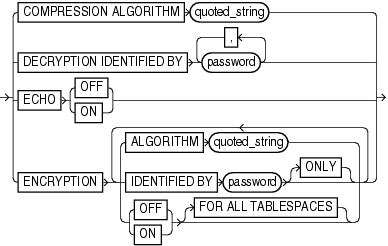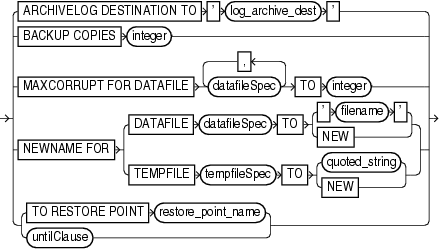SET
Use the SET command to control RMAN behavior within a job or session. Use CONFIGURE to configure options that persist across sessions.
You can use the SET command either at the RMAN prompt or within a RUN block. When used at the RMAN prompt, changes made by SET persist until you exit the RMAN client (see setRmanOption). When used inside of a RUN block, changes made by SET persist until the end of the RUN block or the next SET command that changes the value of the same attribute (see setRunOption).

Description of the illustration set.gif
(setRmanOption::=, setRunOption::=)

Description of the illustration setrmanoption.gif
(deviceSpecifier::=, formatSpec::=)
setRunOption::=

Description of the illustration setrunoption.gif
(deviceSpecifier::=, formatSpec::=, datafileSpec::=, tempfileSpec::=, untilClause::=)

Description of the illustration setrmanorrunoption.gif
(deviceSpecifier::=, formatSpec::=)
This subclause specifies SET options that are usable outside of a RUN block.
| Syntax Element | Description |
|---|---|
COMPRESSION ALGORITHM'algorithm_name' |
Specifies the compression algorithm for backup sets. This command overrides the current CONFIGURE COMPRESSION ALGORITHM setting for the current RMAN session. The default compression algorithm is BZIP2.
Specify either Note: The view |
DECRYPTIONIDENTIFIED BY password |
Specifies one or more decryption passwords to be used when reading dual-mode or password-encrypted backups.
Password-encrypted backups require the correct password to be entered before they can be restored. When RMAN reads an encrypted backup piece, it tries each password in the list until it finds the correct one to decrypt this backup piece. RMAN signals an error if none of the specified keys work. Note: If restoring from a group of backups created with different passwords, then specify all of the required passwords on the See Also: "Encryption of Backup Sets" |
ECHO {OFF | ON} |
Controls whether RMAN commands appear in the message log. When reading commands from a command file, RMAN automatically echoes them to the message log. When reading commands from standard input, by default RMAN does not echo these commands to the message log. To force RMAN to echo the commands, run the SET ECHO ON command before running your command file. Run SET ECHO OFF to disable echoing to the command log.
The command is useful when % rman TARGET / < in_file > out_file By including |
ENCRYPTION |
Specifies encryption-related options that apply to BACKUP commands that create backup sets for the duration of the RMAN session.
See Also: "Encryption of Backup Sets" |
ALGORITHM 'algorithm_name' |
Specifies the algorithm used during this RMAN session. Overrides the configured default encryption algorithm specified by CONFIGURE ALGORITHM. Possible values are listed in V$RMAN_ENCRYPTION_ALGORITHMS. |
IDENTIFIED BY password [ONLY] |
Specifies whether to employ a user-specified password in backup encryption according to the following rules:
Create a password that is secure. See Oracle Database Security Guide for more information. Note that if the password is not surrounded by quotes, then it is translated internally into upper case. Thus, the following clauses are all synonyms for
Caution: Wallet-based encryption is more secure than password-based encryption because no passwords are involved. You should use password-based encryption only when absolutely necessary because your backups need to be transportable. See Also: "Encryption of Backup Sets" for details on the different encryption modes |
{OFF | ON} |
Specifies whether to encrypt backup sets. If ON, then the default is to encrypt backup sets. If OFF, then the default is not to encrypt backup sets.
This option overrides settings made with the If |
FOR ALL TABLESPACES |
Controls encryption for all tablespaces, overriding any CONFIGURE ENCRYPTION FOR TABLESPACE tablespace_name setting. |
This subclause specifies SET options that are usable within a RUN block.
| Syntax Element | Description |
|---|---|
ARCHIVELOG DESTINATIONTO 'log_archive_dest' |
Overrides the LOG_ARCHIVE_DEST_1 initialization parameter in the target database when forming names for restored archived redo logs during subsequent RESTORE and RECOVER commands. RMAN restores the logs to the destination specified in 'log_archive_dest'.
You can use this command to stage archived logs to different locations while restoring a database. RMAN knows where to find the newly restored archived logs; it does not require them to be in the destination specified by Use this parameter to restore archived redo logs that are not already on disk. RMAN always looks for logs on disk first before restoring them from backups. |
BACKUP COPIES integer |
Specifies the number of copies of each backup piece that the channels should create: 1, 2, 3, or 4 (see Example 2-136).
RMAN can duplex backups to either disk or tape but cannot duplex backups to tape and disk simultaneously. When backing up to tape, ensure that the number of copies does not exceed the number of available tape devices. Also, if The The The names of the backup pieces are dependent on the Note: Note: Control file autobackups on disk are a special case and are never duplexed: RMAN always writes one and only copy. |
MAXCORRUPTFOR DATAFILE datafileSpecTO integer |
Sets a limit on the number of previously undetected block corruptions that the database will permit in a specified datafile or group of datafiles. The default limit is zero, meaning that RMAN tolerates no corrupt blocks.
The Whether or not the Note: If you specify See Also: |
NEWNAME FORDATAFILE datafileSpec |
Sets the default name for all subsequent RESTORE or SWITCH commands that affect the specified datafile. If you do not issue this command before the datafile restore operation, then RMAN restores the file to its default location.
After you restore a datafile to a new location, then you can run You cannot use Note: The See Also: |
NEWNAME FORTEMPFILE tempfileSpec |
Sets the new tempfile name for a subsequent SWITCH command that renames the specified tempfile to the specified name.
You cannot use Note: The See Also: |
TO 'filename' |
Specifies a user-defined filename or Automatic Storage Management disk group for the restored datafile or tempfile. If you set the NEWNAME to a disk group for a datafile and run a RESTORE, then RMAN restores the file to the disk group. If you specify a filename for a tempfile, then this will the new name of the tempfile after the database is recovered and opened. |
TO NEW |
Creates an Oracle-managed file in the directory specified in DB_CREATE_FILE_DEST. If the original file is an Oracle-managed file or is on an Automatic Storage Management disk group, then RMAN attempts to delete the original file. If you specify TO NEW for a tempfile, then the tempfile is created in DB_CREATE_FILE_DEST when the database is opened.
You cannot use this option when using the See Also: Oracle Database Administrator's Guide for information about Oracle-managed files |
TO RESTORE POINTrestore_point_name |
Specifies a restore point for a subsequent RESTORE or RECOVER command, with the SCN at which the restore point was created as the upper, inclusive limit. Because the limit is inclusive, RMAN selects only files that can be used to restore or recover up to and including the SCN corresponding to the restore point.
Note: You can only use |
untilClause |
Specifies an end time, SCN, or log sequence number for a subsequent RESTORE or RECOVER command.
See Also: |
This subclause specifies SET options that are usable inside or outside of a RUN block.
| Syntax Element | Description |
|---|---|
AUXILIARY INSTANCE PARAMETERFILE TO 'filename' |
Specifies the path to the parameter file to use in starting the instance. You can use this parameter when customizing TSPITR with an automatic auxiliary instance or when cloning RMAN tablespaces with RMAN.
Note: The See Also: Oracle Database Reference for more on |
COMMAND ID TO 'string' |
Enters the specified string into the V$SESSION.CLIENT_INFO column of all channels. Use this information to determine which database server sessions correspond to which RMAN channels. The SET COMMAND ID command applies only to channels that are already allocated.
The
The first form appears in the RMAN target database connection. The second form appears in all allocated channels. When the current job is complete, the See Also: Oracle Database Reference for more on |
CONTROLFILE AUTOBACKUPFORMAT FOR DEVICE TYPEdeviceSpecifierTO formatSpec |
Overrides the default filename format for the control file autobackup on the specified device type. You can use this command either in RUN or at the RMAN prompt. The order of precedence is as follows:
The See Also: |
DBID integer |
Specifies the DBID, which is a unique 32-bit identification number computed when the database is created.
RMAN displays the DBID upon connection to the target database. You can obtain the DBID by querying the You should only run the
|
Example 2-135 Setting the Command ID
This example sets the command ID to rman, backs up the database, and then archives the online redo logs. You can use the command ID to query V$SESSION with WHERE LIKE '%rman%' for job status information.
RUN
{
ALLOCATE CHANNEL d1 DEVICE TYPE DISK FORMAT '/disk1/%U';
ALLOCATE CHANNEL d2 DEVICE TYPE DISK FORMAT '/disk2/%U';
SET COMMAND ID TO 'rman';
BACKUP INCREMENTAL LEVEL 0 DATABASE;
SQL 'ALTER SYSTEM ARCHIVE LOG CURRENT';
}
Example 2-136 Duplexing a Backup Set
Assume that the current duplexing configuration is as follows:
CONFIGURE ARCHIVELOG COPIES FOR DEVICE TYPE sbt TO 3; CONFIGURE DATAFILE COPIES FOR DEVICE TYPE sbt TO 3;
One of the tape drives goes bad, leaving only two available. The guideline for tape backups is that the number of devices should equal the number of copies multiplied by the number of channels. The following example overrides the persistent duplexing configuration with SET BACKUP COPIES and writes two copies of a database backup to the two functioning tape drives:
RUN
{
ALLOCATE CHANNEL dev1 DEVICE TYPE sbt
PARMS 'ENV=(OB_DEVICE_1=stape1,OB_DEVICE_2=stape2)';
SET BACKUP COPIES 2;
BACKUP DATABASE PLUS ARCHIVELOG;
}
Example 2-137 Setting the Control File Autobackup Format During a Restore
Assume that the disk containing the control file fails. You edit the CONTROL_FILES parameter in the initialization parameter file to point to a new location.
In this example, you do not have access to a recovery catalog. The example starts the instance, sets the DBID, and then restores a control file autobackup. After the database is mounted, you can recover the database.
CONNECT TARGET /
STARTUP FORCE NOMOUNT
SET DBID 28014364;
RUN
{
SET CONTROLFILE AUTOBACKUP FORMAT FOR DEVICE TYPE DISK TO '/disk2/cf_%F.bak';
RESTORE CONTROLFILE FROM AUTOBACKUP MAXSEQ 100;
}
ALTER DATABASE MOUNT;
RECOVER DATABASE;
ALTER DATABASE OPEN RESETLOGS;
Example 2-138 Restoring the Server Parameter File
Assume that the database is shut down while maintenance is being performed on the database host. During this time, the server parameter file is accidentally deleted. You start the RMAN client, CONNECT as TARGET to the database, and connect to the recovery catalog. The following example restores a server parameter file from an autobackup on tape and then restarts the instance.
SET DBID 3257174182; # set dbid so RMAN can identify the database
STARTUP FORCE NOMOUNT # RMAN starts database with a dummy server parameter file
RUN
{
ALLOCATE CHANNEL t1 DEVICE TYPE sbt;
RESTORE SPFILE FROM AUTOBACKUP;
}
STARTUP FORCE; # RMAN restarts database with restored server parameter file